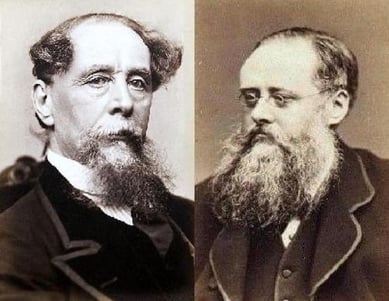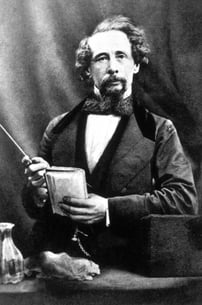The famous literary friendship between Charles Dickens and Wilkie Collins began not in the world of the written word but on the stage. A mutual friend of the two, the Dickensianly-named painter Augustus Egg, connected Dickens to the younger Collins, who was a budding writer in his late twenties. Like Dickens, Collins was happy to perform on occasion, and in an amateur play production, he played the valet to Dickens’s leading role, a dandyish aristocrat named Lord Wilmot.
 The play that the pair appeared in was called Not So Bad As We Seem, written by Dickens’s contemporary, Edward Bulwer-Lytton, of “It was a dark and stormy night” fame. By the time the two met in 1851, Dickens was 39 and already famous. Collins, twelve years his junior, was years away from writing his most important work, but the two of them hit it off immediately. The play would ignite a two-decades-long friendship, lasting until Dickens’s death in 1870.
The play that the pair appeared in was called Not So Bad As We Seem, written by Dickens’s contemporary, Edward Bulwer-Lytton, of “It was a dark and stormy night” fame. By the time the two met in 1851, Dickens was 39 and already famous. Collins, twelve years his junior, was years away from writing his most important work, but the two of them hit it off immediately. The play would ignite a two-decades-long friendship, lasting until Dickens’s death in 1870.
By the next year, Collins was already spending time at the Dickenses’ summer home in Dover. Charles Dickens, multi-hyphenate that he was, ran a weekly literary periodical entitled Household Words. The elder writer invited Collins to write for it, and in 1852, he published Collins's short story, “A Terribly Strange Bed.” The tale was about a gambler, who, after winning a lot of money, spends the night at an inn. Soon, the gambler realizes that his four-poster bed is rigged to crush him, with the canopy moving downward like a screw press, orchestrated so that the inn’s proprietors may kill him to steal his winnings.
Collins continued to contribute to the magazine, and four years later, was hired as a staff member at Household Words. Collins found both encouragement and career opportunities in his friendship with Charles Dickens, and Dickens found a respected friend who leaned, to his delight, toward the bohemian. The pair became traveling buddies, sometimes prowling the seedy districts of Paris and London at midnight. In his friendship with Collins, Dickens could indulge his more adventurous and ribald side whenever he got tired of being the immensely proper and public figure that he was.
 Collins was frank about his sexual past, which Dickens took some interest in hearing about. In correspondence, Dickens often drifted into joyful, prurient innuendo. Crucial was the role Collins played during the dissolution of Charles Dickens's marriage. In 1857, the pair went to see a play in London, in which a teenage actress named Ellen Ternan performed. Soon, Ternan would meet Dickens, and they would become lovers, an arrangement to which Collins was to some degree an accomplice. Under the guise of collaborating for a travelogue for Household Words, which the pair wrote and named “The Lazy Tour of Two Idle Apprentices,” Dickens was able to follow Ternan around England while she was on tour.
Collins was frank about his sexual past, which Dickens took some interest in hearing about. In correspondence, Dickens often drifted into joyful, prurient innuendo. Crucial was the role Collins played during the dissolution of Charles Dickens's marriage. In 1857, the pair went to see a play in London, in which a teenage actress named Ellen Ternan performed. Soon, Ternan would meet Dickens, and they would become lovers, an arrangement to which Collins was to some degree an accomplice. Under the guise of collaborating for a travelogue for Household Words, which the pair wrote and named “The Lazy Tour of Two Idle Apprentices,” Dickens was able to follow Ternan around England while she was on tour.
As collaborators, the theater proved a fruitful place for Collins and Dickens. Dickens helped the former on his play, The Lighthouse (1855). They later worked on The Frozen Deep (1856), which they wrote together and in which Dickens performed. On July 4, the author showed off his other talent to an appreciative audience, which included Hans Christian Andersen and Queen Victoria.
The play also helped Dickens to solidify his relationship with Ellen Ternan. And it would not be the only romance to be facilitated by their friendship. Wilkie’s brother, Charles, would propose and marry Dickens’s eldest daughter, Catherine. Dickens did not formally object to the marriage, but was wary of Charles Collins’s illness, the result of which made the couple financially dependent on Dickens when Charles Collins could not find work.
 A highlight in both Collins’s and Dickens’s careers came from when Charles Dickens established a new literary magazine after he departed from Household Words, this time called All the Year Round. It first serialized A Tale of Two Cities, but being a somewhat short novel, it needed a new book to disseminate, and Dickens chose Collins's latest work, The Woman in White (1859). The suspenseful, cliffhanger-filled story helped boost the weekly’s circulation from 38,000 to as much as 300,000. Collins had began to make himself a household name, and further impressed Dickens in the meantime.
A highlight in both Collins’s and Dickens’s careers came from when Charles Dickens established a new literary magazine after he departed from Household Words, this time called All the Year Round. It first serialized A Tale of Two Cities, but being a somewhat short novel, it needed a new book to disseminate, and Dickens chose Collins's latest work, The Woman in White (1859). The suspenseful, cliffhanger-filled story helped boost the weekly’s circulation from 38,000 to as much as 300,000. Collins had began to make himself a household name, and further impressed Dickens in the meantime.
When Collins began to become debilitated by rheumatic gout (which also drove his addiction to laudanum), Dickens offered to finish his work in progress, the novel No Name (1862), stating that it would be “so like you as that none should find out the difference.” It is telling that Dickens felt like he understood his dear friend so much that he would be able to take his artistic voice and imitate it. For when Dickens died and Collins was offered the opportunity to complete Edwin Drood, the writer refused, saying it was the work of a brain too “worn-out.”
Collins lived nineteen more years after Dickens’s death, although he had his best fiction behind him, including his magnum opus, The Moonstone (1868). Both writers, who had produced some of their best work in close friendship to each other, helped forge what remains one of the most fruitful and illuminating artistic friendships of the modern era.









